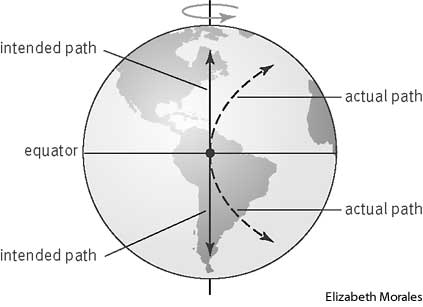Do Toilets Flush the Opposite Way in the Southern Hemisphere?
Our planet is capable of producing some massive storm systems, one of which is hurricanes. We learn early on that in the Northern hemisphere, hurricanes rotate counterclockwise and in the Southern hemisphere, clockwise. Somehow along the way, this idea was extrapolated to include other types of rotating systems like toilets flushing or water draining from a tub. Is this a logical connection or just foolishness?
Understanding the Coriolis Effect
The Coriolis Effect (also called the Coriolis Force) is a phenomenon directly related to rotating objects. Picture yourself on a merry-go-round that is spinning counterclockwise. You have the option of sitting close to the edge or close to the middle. Opting for a spot close to the center of rotation, you find that as the carnival ride spins around you are moving fairly slowly. Getting bored of this you decide to move yourself to another position, this time right at the edge. Even though the merry-go-round is still going around and around at the same rate, you now feel yourself speeding through the air.
Now imagine staying on the edge while a friend sits near the middle, directly in line with you. As both of you spin around counterclockwise, you toss a tennis ball to your friend. Even though you threw the ball in straight line toward the center, you will find that the ball ends up veering to the right, landing in front of your friend instead of in his or her hands.
This is because when the ball was tossed, it was moving at the same speed as you, meaning it has some angular momentum. As the ball leaves your hands, it maintains this angular momentum as it flies through the air toward your friend. But since your friend is rotating at a slower rate than you, he or she is not going fast enough to catch up in time to a faster moving ball.
Hurricanes
To understand how the Coriolis Effect works on earth, simply take the merry-go-round idea and apply it to a 3-dimensional rotating body. This means that if you are standing at the equator, you are moving faster to the East (rotation of the Earth) than someone who is standing in Kansas, for instance. If it were possible to throw a tennis ball hundreds of miles, you could try throwing the ball from the equator to your friend and again find that the ball lands to the right of them instead of in their hands. The image below illustrates this idea.
When hurricanes form, they easily can be hundreds of miles in diameter. In fact, quite a few hurricanes have had a diameter near 1,000 miles across. At the center of every hurricane is an area of low pressure surrounded by high pressure air. This causes the high pressure air around the center to rush inward.
As the wind rushes toward the center it experiences the same effect that the tennis ball does as it’s tossed to your friend in the middle of a merry-go-round or in the middle of America. The closer the wind moves toward the center, the more it starts to veer off to the right as it maintains its angular momentum. It is precisely this veering motion that gives a hurricane its counterclockwise rotation in the northern hemisphere. For hurricanes that form south of the equator, the same effect is in play but in the opposite direction; this means that hurricanes in the southern hemisphere will rotate clockwise.
What about toilets, then?
The important thing to realize about the Coriolis Effect on Earth is that it presents itself at very large scales (as it does in hurricanes). When dealing with a toilet or a bathtub, the distance between the water and the drain are incredibly small when compared with the distance from the edge of a hurricane to its center. For this reason, the Coriolis Effect is simply too small to carry any influence. If you’ve ever noticed when flushing a toilet, the water is shot out of jets near the rim at an angle, not directly toward the middle. The angle of these jets has a far greater influence on the flow of water than does the Coriolis Effect.
With a full bathtub, the water’s choice to rotate clockwise or counterclockwise is based on subtle biases within the environment, such as the motion of your hand as you reach down to pull the drain plug out, or even an imperfection in the shape of the tub. In either case, the Coriolis Effect is so infinitesimally weak at this scale that any other myriad of factors will overwhelming dictate which way the water begins to spiral.
So yes, claiming that all toilets flush in the opposite direction in the southern hemisphere is in fact, foolish.




